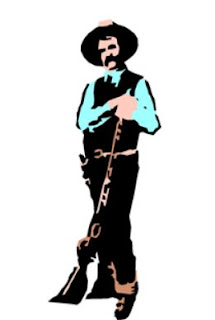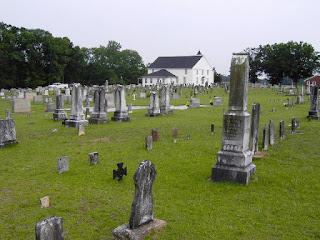Catherine Klausman (nee Kronenwetter) was born St. Marys in 1875. She was the daughter of Nicholas Kronenwetter, an immigrant from Wurtemburg, Germany, and Barbara Bindel Kronenwetter, a native Pennsylvanian. She had one sister who later became a nun. Although Catherine could read and write, her schooling appears to have been limited. By the age of 22 she had met and married William Aloysius Klausman, who was four years older and likewise had been born in St. Mary’s.
Their home town, shown above in an 1895 map, had been founded by devout Bavarian Roman Catholics in 1842 originally as “Marienstadt,” (Mary’s City). It is situated in North Central, Pennsylvania, in Elk County, so called because it is the center of the state’s elk country. The Klausman’s home town was nestled within a wooded region with some agriculture and mining of coal and other minerals.
 At an early point William became the proprietor of “The German House,” a saloon, liquor store and small hotel located on Railroad Street, not far from the depot where trains disgorged their passengers. Shown here is a photo of the German House, taken in 1906. The man with a hat standing to the right in the photo is believed to be William Klausman. The other figure is that of Charlie (aka Henry) Groll, the bartender. Note that St. Marys still had wooden sidewalks. The door on the left with white curtains was the ladies’ entrance. A passageway took women around the bar and back to the hotel restaurant.
At an early point William became the proprietor of “The German House,” a saloon, liquor store and small hotel located on Railroad Street, not far from the depot where trains disgorged their passengers. Shown here is a photo of the German House, taken in 1906. The man with a hat standing to the right in the photo is believed to be William Klausman. The other figure is that of Charlie (aka Henry) Groll, the bartender. Note that St. Marys still had wooden sidewalks. The door on the left with white curtains was the ladies’ entrance. A passageway took women around the bar and back to the hotel restaurant.
The German House was one of the more ornate buildings in town and had a pressed metal facade, a common architectural feature of the nineteenth and early twentieth century. This one was made by the Mesker Brothers Iron Works of St. Louis, a well-known manufacturer and designer of ornamental sheet-metal facades and cast iron storefronts. The design had been selected by perusing Mesker’s catalogue of facings, taking measurements and ordering by mail. The hotel still stands, part of the St. Marys Historical District, with the ironwork intact and a plaque attached by the Meskers. A photo of the interior of the barroom, below, showing patrons hoisting beers, was also appears to be well-designed space. Groll is identified as the man standing behind the bar.
By this time, William and Catherine Klausman had a family. Son Karl was born in 1899 when she was 22, followed by Albert (1902), Gertrude (1906) and Helen Marie (1909). The 1910 census found the family living at 22 Railroad Street, the German House. In addition to their hotel guests, most of them construction workers, Groll, the hotel cook, a waitress and a porter all were living on the premises.
In 1912, the Klausman’s last child, William, was born. That same year his father, William, suddenly died at the young age of 41. As his family grieved at his gravesite, he was buried in Saint Marys Cemetery, a place where both his own and his wife’s parents were interred. Catherine was left with an infant, a toddler, and three other children under ten. Many women quickly would have sold the German House. Catherine Klausman, however, was made of strong stuff — like the iron facade on the hotel. With the help of Bartender Groll, she kept the place open and prospered by selling both at wholesale and retail her own brands of whiskey.
 Shown here are some of the colorful labels that bear either her name or that of the German House or both. Taking a leaf from the liquor wholesalers and whiskey rectifiers of the time, she was buying product of both Pennsylvania and Kentucky and sometimes blending the spirits, bottling them and then applying her own labels. My favorite is Mrs. Klausman’s “Corn Whiskey,” with its predominantly yellow label showing a rural distillery and a shock of corn, a design worthy of one of the big urban liquor outfits.
Shown here are some of the colorful labels that bear either her name or that of the German House or both. Taking a leaf from the liquor wholesalers and whiskey rectifiers of the time, she was buying product of both Pennsylvania and Kentucky and sometimes blending the spirits, bottling them and then applying her own labels. My favorite is Mrs. Klausman’s “Corn Whiskey,” with its predominantly yellow label showing a rural distillery and a shock of corn, a design worthy of one of the big urban liquor outfits.  Another outstanding label was the German House bottled “Beech Grove Whiskey.” This a brand from a Boston wholesaler named C.H. Graves. The red seal in the center shows two colonial types with the motto “United We Stand, Divided We Fall.” “Kentucky Dew,” despite its name was a Pennsylvania product, from 23rd Revenue District, one that contained no fewer than 80 individual distilleries from which these supplies might have been drawn.
Another outstanding label was the German House bottled “Beech Grove Whiskey.” This a brand from a Boston wholesaler named C.H. Graves. The red seal in the center shows two colonial types with the motto “United We Stand, Divided We Fall.” “Kentucky Dew,” despite its name was a Pennsylvania product, from 23rd Revenue District, one that contained no fewer than 80 individual distilleries from which these supplies might have been drawn.  Mrs. Klausman also apparently was bottling — or arranging bottling under the German House (or alternatively “German Hotel”) name, of nationally known brands. “Boston League” whiskey was the product of a Cincinnati wholesaler/rectifier, Ferdinand Westheimer, who was obtaining his supplies in Kentucky. Two Sam Thompson labels are shown below, one that accompanied a quart bottle and the other a half-pint flask. Thompson’s was a well known “Monongahela Rye” straight whiskey, distilled on the shores of the river near Brownsville, Pennsylvania. Mrs. Klausman clearly had good taste in whiskey.
Mrs. Klausman also apparently was bottling — or arranging bottling under the German House (or alternatively “German Hotel”) name, of nationally known brands. “Boston League” whiskey was the product of a Cincinnati wholesaler/rectifier, Ferdinand Westheimer, who was obtaining his supplies in Kentucky. Two Sam Thompson labels are shown below, one that accompanied a quart bottle and the other a half-pint flask. Thompson’s was a well known “Monongahela Rye” straight whiskey, distilled on the shores of the river near Brownsville, Pennsylvania. Mrs. Klausman clearly had good taste in whiskey.
By 1920, however, National Prohibition had brought a close to the thriving business she was doing with whiskey sales. Moreover, the hotel bar no longer could serve alcohol. Regardless of these setbacks, however, she persevered in running the hotel The 1920 census found her still living at the German House, a widow, with her five children still with her. Karl was an adult of 21 and helping in the hotel, as were the other children down to seven-year-old William. At the time of the 1930 census, Catherine, now 54, was continuing to run the hotel. Her two youngest children were still with her. Mrs. Klausman operated the German House as a hotel through the 1930s, but there is no evidence that after repeal of National Prohibition in 1934, she went back to liquor sales.

 When she died in 1963, at the age of 88, she was buried next to William in the St. Marys Cemetery. As noted earlier, the German House building remains standing as part of the town’s historic district on Railroad Street. A 2010 photo below shows the iron facade — the structure with the street light in front —but it appears that the building may have been boarded up.
When she died in 1963, at the age of 88, she was buried next to William in the St. Marys Cemetery. As noted earlier, the German House building remains standing as part of the town’s historic district on Railroad Street. A 2010 photo below shows the iron facade — the structure with the street light in front —but it appears that the building may have been boarded up.

 When she died in 1963, at the age of 88, she was buried next to William in the St. Marys Cemetery. As noted earlier, the German House building remains standing as part of the town’s historic district on Railroad Street. A 2010 photo below shows the iron facade — the structure with the street light in front —but it appears that the building may have been boarded up.
When she died in 1963, at the age of 88, she was buried next to William in the St. Marys Cemetery. As noted earlier, the German House building remains standing as part of the town’s historic district on Railroad Street. A 2010 photo below shows the iron facade — the structure with the street light in front —but it appears that the building may have been boarded up.
Including Mary Dowling and Mary Moll, I have profiled three women on this blog who inherited a whiskey-related business from a deceased husband. Among the three, however, Catherine Klausman is unique. She continued to run the German House and expanded operations to include bottling and wholesaling of both her own and other brands of whiskey, while bearing the simultaneous responsibility of raising five minor children. Little wonder the name “Mrs. Klausman” was uttered with respect on the streets of St. Marys.
Note: Both Ferd Westheimer and Sam Thompson, referenced on labels above, have been subjects of my prior posts: Westheimer in May 2014, and Thompson in September 2012. My post on Mary Dowling was January 2014 and on Mary Moll, October 2015.






































